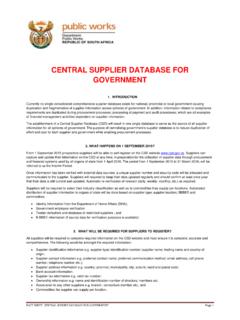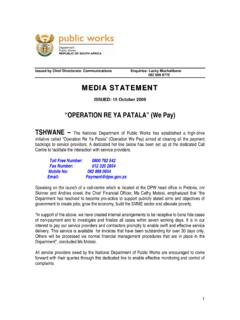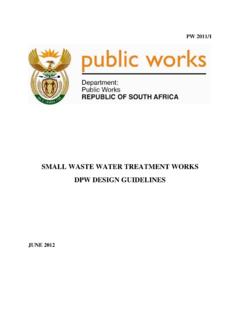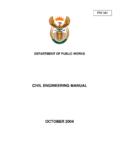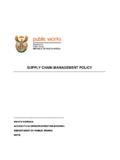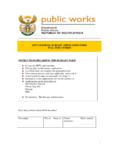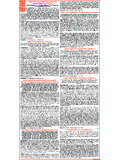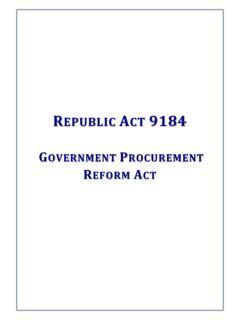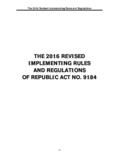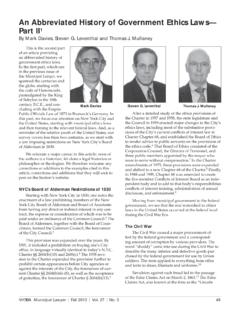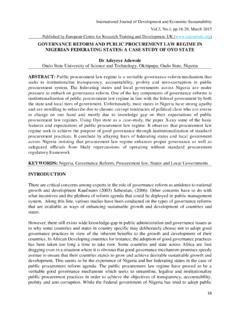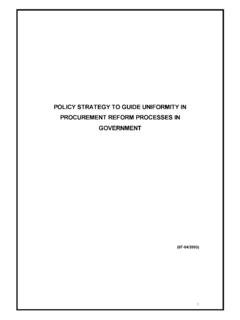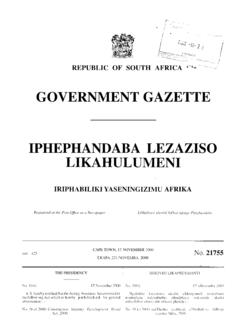Transcription of National Treasury SUPPLY CHAIN MANAGEMENT …
1 National Treasury SUPPLY CHAIN MANAGEMENT Zero Tolerance Against Fraud And Corruption Conference 25 26 September 2007 Henry MalingaSeptember 2007 Contents Background Legislative Environment SCM Process Acquisition Process PPPFA and BBBEE Alignment Prevention and Combating of Corruption Success FactorsThe previous approach of acquiring goods and services in government was highly prescriptive and had, amongst others, the following deficiencies: inconsistency in policy application, lack of accountability, lack of supportive structures, fragmented processes, etcBackgroundSince 1995 government has been involved in a number of initiatives to reform the procurement environment: Green paper on public procurement Roger Webb Procurement analysis CPAR (Country Procurement Assessment Report)-World BankThe above initiatives resulted in the introduction of the INTEGRATED SUPPLY CHAIN MANAGEMENT function in above initiatives resulted in the introduction of the INTEGRATED SUPPLY CHAIN MANAGEMENT function in following was approved by Cabinet A fifth pillar in respect of equity be included That the Minister of Finance issue general procurement guidelines, including the criteria of Black Economic Empowerment, capacity building, training and job creation The National & Provincial Tender Boards and the various offices be phased out.
2 A Common Service Provider on a cost recovery basis be established. That a pilot programme of procurement reform be implemented in four National departments. That the need for a White Paper on procurement reform is superceded by these decisionsJoint CPAR 2001A range of issues that required resolution was related issues Insufficient Planning and linking to budget Lack of uniform bid and other procedures Conflict of interest due to composition of Tender Bodies Consultants not selected in systematic competitive manner Flaws (corruption) in award of tenders Insufficient training of staff Procurement Processes too rule drivenIssues with the Preferential Procurement Policy Framework Act (PPPFA) and its regulations. PPPF Policies not formulated well due to lack of National targets Cost and outcomes not adequately assessed to evaluate merits of system Incorrect interpretation of Policy (set-asides) Not adequately evaluating who qualified as disadvantaged (verifying claims for preference points) Does not cater for capacity building for disadvantaged enterprises Lack of quantitative data on cost and outcome of preferential system No provision for graduation Conflicting policiesThe conclusions of the CPAR formed the basis for further work done in collaboration with provinces and other ENVIRONMENTTHAT SUPPORTED PROCUREMENT REFORMIN GOVERNMENTLEGISLATIVE ENVIRONMENTS ection 217(I) of The Constitution provides the basis for procurement by determining that.
3 When an organ of state in the National , provincial or local sphere of government , or any other institution identified in National legislation, contracts for goods and services, it must do so in accordance with a system which is fair, equitable, transparent, competitive and cost-effective .Section 217(I) of The Constitution further confers:an obligation for National legislation to prescribe a framework providing for preferential procurement to address the social and economic imbalances of the Preferential Procurement Policy Framework Act (PPPFA) of 2000 and its accompanying Regulations were promulgated to achieve these goals. (This Act incorporated the 80/20 and 90/10 preference point systems.)Section 215-219 of The Constitution further require that: The National Treasury introduce norms and standards within government to prescribe transparency and expenditure control measures, which should include best practices to regulate financial MANAGEMENT in the National and provincial spheres of Municipal Finance MANAGEMENT Act (MFMA) has also been promulgated: Extend the same principles to municipalitiesLEGISLATIVE ENVIRONMENT Thus, it is the responsibility of the National Treasury to: foster coherent financial MANAGEMENT in all organs of State, across all spheres of government ; at the same time, ensure that considerable powers are devolved to accounting officers to enable them to manage their affairs within the parameters laid down by the prescribed norms and standards.
4 Section 76(4)(c) of the Public Finance MANAGEMENT Act (PFMA) provides that : The National Treasury may issue a procurement framework for National and provincial departments; A similar provision is also contained in chapter 11 of the Municipal Finance MANAGEMENT Act (MFMA) that is applicable to framework is to ensure the optimal achievement of government s broader strategic ENVIRONMENTM ajor shifts from the Webb ReportEstablish parameters for the SUPPLY CHAIN MANAGEMENT Office in the National Treasury to: Monitor adherence to minimum norms and standards as well as policy outcomes. Facilitate the arrangement of transversally used term CHAIN ManagementThe concept of an integrated SUPPLY CHAIN MANAGEMENT policy system was proposed SUPPLY CHAIN MANAGEMENT could be described as a function that ensures that goods and services are delivered to the right place, in the right quantity, with the right quality, at the right cost and at the right process is aimed at : Introducing international best practices as part of government s drive towards improved financial MANAGEMENT .
5 Replacing the outdated procurement and provisioning processes. Introducing uniformity in SUPPLY CHAIN MANAGEMENT policies and standards in all spheres of government . On 10 September 2003, Cabinet approved the adoption of a Policy Document, titled Policy to Guide Uniformity in Procurement Reform Processes in government This policy strategy is intended to guide the uniform implementation of government s procurement reform initiatives and the issuing of Regulations of the Framework for SUPPLY CHAIN MANAGEMENT . The Minister of Finance approved the promulgation of the Regulatory Framework for SUPPLY CHAIN MANAGEMENT on 05 December 2003. Accounting officers / authorities are required to establish and implement a SUPPLY CHAIN MANAGEMENT function that promotes sound financialmanagement and uniformity in all spheres of CHAIN MANAGEMENT PROCESSS upply CHAIN MANAGEMENT ProcessSUPPLY CHAIN PERFORMANANCEDATABASE/SGOVERNMENT S PREFERENTIALPROCUREMENT POLICY OBJECTIVESD emandAcquisitionLogisticsDisposalINFRAST RUCTURE (SYSTEMS)RISK MANAGEMENTACQUISITION PROCESSA cquisition ProcessContractingAdjudicationRecommenda tionsEvaluationBid SpecificationSourcing Strategy 1234567 The Bid Committee.
6 Business Owner Technical Financial SCM Unit LegalThe Adjudication CommitteeThe SCM UnitThe Business OwnerPreferential Procurement Policy Framework Act (PPPFA)andBroad-Based Black Economic Empowerment Act(BBBEEA)PPPFA and BBBEE Alignment Ambiguities between PPPFA and BBBEEA were identified thus the need for the alignment of the two legislations. Some of these ambiguities were inconsistency in the policy application The definition of HDI was too broad leading to huge fronting BBBEE and PPPFA were out of sync Cabinet instructed that the two legislations be alignedPPPFA and BBBEE Alignment cont. A work group was established between National Treasury and the BEE unit of the Department of Trade and Industry to deal with the alignment Draft amendment of the Preferential Procurement Policy FrameworkAct is currently with the state law advisors for legal refinement.
7 The legislative process shall start soon. Prevention and Combating of CorruptionPrevention and Combating of CorruptionCombat abuse of SCM system Accounting officers should take all reasonable steps to prevent abuse of the scm system. Accounting officers must reject a bid from any bidder who:-has abused the scm system or who has committed any improper conduct;-has been convicted for fraud or corruption during the past five (5) years;-has willfully neglected or failed to comply with any public sector contract during the past five (5) years;-has been listed in the Register for Tender Defaulters in terms of section 29 of the Prevention and Corrupt Activities Act (No 12 of 2004). Combat abuse of SCM system (cont.) Accounting officers must cancel a contract awarded to a person if:-the person committed any corrupt or any fraudulent act during the bidding process or execution of the contract;-an official or other role player committed any corrupt or fraudulent act during the bidding process or execution of the contract that benefited that and Combating of CorruptionREGISTER FOR TENDER DEFAULTERSP revention and Combating of Corrupt Activities Act, Act No.
8 12 of 2004 Background Section 29 of the Act provides for the Establishment, Maintenance and MANAGEMENT of a Register for Tender Defaulters. Register to contain particulars of persons or enterprises convicted by a court for corrupt activities relating to tenders,contracts and procurement (sections 12 and 13)Prevention and Combating of CorruptionNational Treasury s Role in the Implementation of the Act Minister of Finance approved that the Registrar should be from the National Treasury . On 9 March 2005, a Registrar was appointed. The Regulations Regarding the Register for Tender Defaulters was approved for promulgation by the Minister of Finance in consultation with Justice. Promulgated on 11 March 2005 in government Gazette 27365. Department of Justice to furnish the National Treasury with details of all convictions relating to sections 12 and 13 of the Act.
9 A copy of the Register has been placed and will be maintained on the web-page of National Treasury . Accounting Officers need to put in place a mechanism to deal with grievances relating to the SCM process. National Treasury is currently looking at establishing a National Compliance monitoring unit to deal with deviations from SCMP revention and Combating of CorruptionDatabase of Restricted Persons Treasury Regulation (c) prescribes that prior to awarding any contract the National Treasury s database of persons prohibited from doing business must be checked. This database contains details of persons restricted from doing business with government for having obtained preference fraudulently or have failed to attain specified goals during the performance of the contract. These restrictions have been imposed by the former tender boards or accounting officers and not by a court of law.
10 The database is therefore not accessible to the public. SUPPLY CHAIN MANAGEMENT Practice Note Number 5 of 2006 issued on09 October 2006 empowers accounting officers to restrict suppliers from doing business with government . The General Conditions of Contract has been augmented accordingly to give effect to these and Combating of CorruptionSUCCESS FACTORSS uccess Factors SUPPLY CHAIN has found its rightful place in government SCM has been implemented in all spheres of government Strategic SourcingEVERY ATTEMPT SHOULD BE MADE TO DEAL WITH THE AQUIRING OF GOODS AND SERVICES IN THE SPIRIT OF SECTION 217 OF THE CONSTITUTION OF THE REPUBLIC OF SOUTH AFRICATHANK YOUFor further details: National Treasury SUPPLY CHAIN MANAGEMENT Policy (012) 315 5502 SUPPLY CHAIN MANAGEMENT Process (Demand) Understanding future needs Identifying critical delivery dates The frequency of need Linking the requirement to the budget Doing an expenditure analysis Determining the specifications Doing a commodity analysis Doing an industry analysisDemand ManagementBACKS upply CHAIN MANAGEMENT Process (Logistics)Logistics MANAGEMENT For stock or inventory items the following functions will amongst others be performed: Coding of items Setting of inventory levels Placing of orders Receiving and distribution of material Stores/Warehouse MANAGEMENT Expediting MANAGEMENT Transport MANAGEMENT .
